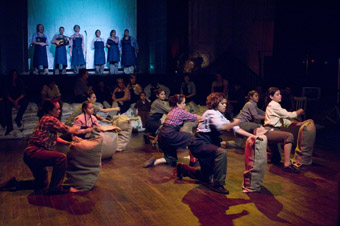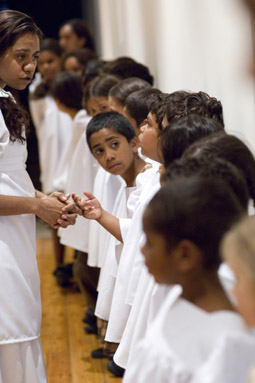port adelaide reanimated
sam haren rides into the past with kurruru & vitalstatistix

Second To None, Kurruru Indigenous Youth Performing Arts & Vitalstatistix Theatre Company
photo Shane Reid
Second To None, Kurruru Indigenous Youth Performing Arts & Vitalstatistix Theatre Company
“THE WHITES ALMOST MISSED OUT.” WITH AN IMAGE OF A WHITE MAN AND WOMAN, THIS LINE APPEARED ON THE FRONT OF THE OFFICIAL NEWSLETTER OF THE MULTI-MILLION DOLLAR NEWPORT QUAYS PROPERTY DEVELOPMENT PROJECT IN PORT ADELAIDE. THE ADVERTISEMENT RECOUNTS HOW ‘MR AND MRS WHITE’ NEARLY MISSED OUT ON THEIR DREAM PROPERTY AS PART OF THE CURRENT GENTRIFICATION OF THE PORT. THIS SERVES AS A HIGHLY IRONIC BACKDROP FOR SECOND TO NONE, AN EPIC SITE-SPECIFIC PERFORMANCE EXPLORING THE INDIGENOUS AND MARITIME HISTORIES OF PORT ADELAIDE AGAINST ITS FUTURE.
Second to None is a co-production between two unique Australian theatre companies based in Port Adelaide with strong ties to its history and communities—Kurruru (Australia’s only Indigenous youth performing arts company) and Vitalstatistix (Australia’s national women’s theatre company).
In the tradition of much site-specific performance, the sites serve as both subject and locale. Their meanings and histories are ‘excavated’ and transformed into performance that writes back over the site, a palimpsest of its present reality with reanimations of its past.
The audience encounters three slippery property developers (Sam McMahon, David Pidd, Stephen Noonan) who offer to take us on an exciting tour of Port Adelaide’s future. We are divided into three buses and are taken to the centrepiece site for the development (formerly the historic Hart’s Mill) overlooking the Port River. It is here that the tour is ‘hijacked’ (or reappropriated) when three young Indigenous women (Lisa Flanagan, Nazaree Dickerson, Jada Alberts) board the buses and offer to take the audience on another kind of journey altogether.

Uraine Mastrosaras and children, Second To None
photo Shane Reid
Uraine Mastrosaras and children, Second To None
The travelling mode of performance, using the metaphor of the guided bus tour, transforms all we see out of the window into the backdrop for this performance. I listen to our new guide (Flanagan) as she tells us about the Indigenous history of the surrounding area as we drive away from Hart’s Mill further into the Port. She tells us about the day to day life here before white colonisation juxtaposing it with the Port’s urban landscape we are observing. Suddenly there’s an image of the past the guide is describing—three generations of Indigenous women on a roundabout, collecting firewood. We drive away, returning to the urban present.
We disembark the bus at Glanville Hall, a grand lodge built in 1856, which later served as a home for young Aboriginal boys in the 1940s. This site is about “being made white” offering an experience of the hall through the eyes of the young Aboriginal children who once lived there. I look into a room to see an eerie image of a young Aboriginal boy in white garb whitewashing trees. In a central room there is another simple but powerful image—a line of perhaps 20 Aboriginal children, again in white, lined up according to height, under the watchful eye of an Anglican minister. We look at this line-up for some time. For the largely white audience the image’s resonance with the plight of the Stolen Generations is palpable.
The buses travel to a second site-specific event at an outdoor location near the beach at Largs North called Kauwangga, an important site for hunting and gathering for the Kaurna people prior to white colonisation. It’s dark as we enter the sandy site. On the curved surface of a large tree, a video projection of an Aboriginal man’s face appears and speaks. We travel further to a camp fire to witness a performance of traditional cultural practices, entirely in Kaurna language. At one point a giant projection of a kangaroo is sculpted onto a tree in the distance. The young men go off to hunt it and later return. The performance beautifully achieves its aim to revive the traditional cultural practices of the Kaurna people while engaging with the most contemporary of aesthetics in its use of video and sound. As we depart, a soundscape and projections chillingly evoke a massacre.
The Waterside Workers Hall is our final destination, once a centre of political and cultural activities for wharfies and now the home of Vitalstatistix. Here fascinating aspects of maritime history unfold. The wharves were one of the few places where Indigenous people could work in the first half of the 20th century. Now Second to None departs from its immersive site-specific approach in favour of the aesthetic of a community event. Given the preceding journey, I found it hard to empathise with the narrative of white workers. We had seen colonial and commercial appropriations of land by shifty propery developers and oppressive missionaries while witnessing the vibrancy of Indigenous life and the evocation of a horrible massacre.
Finally the audience is invited to join in the dancing of a military two-step. The celebratory atmosphere engendered by this community and its sense of history leaves me wondering what the Whites with their new property will bring in the years to come.
Kurruru Indigenous Youth Performing Arts & Vitalstatistix Theatre Company, Second To None, directors Sasha Zahra, Maude Davey, Karl Telfer, Diat Alferink; original concept/research, Janine Peacock, composer, sound designer Lou Bennett, design Kathryn Sproul, assistant designer Chantal Tremaine Henley, contemporary choreography, Gina Rings, traditional choreography Karl Telfer, lighting design, Kerry Ireland; Port Adelaide, Nov 22-25, 2007
RealTime issue #83 Feb-March 2008 pg. 37






